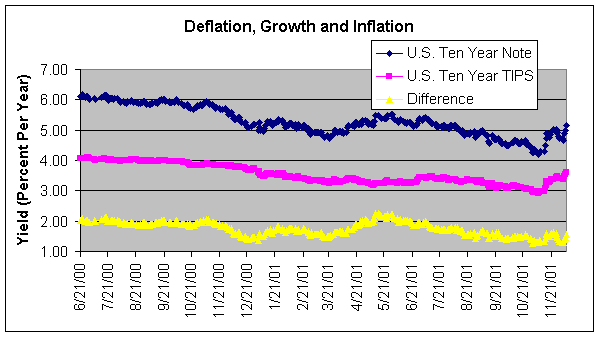December 10, 2001; Deflation, Growth and Inflation
Fear
of Deflation Subsides For Now
The
yield on the benchmark ten-year U.S. Treasury Note has zoomed from a low of
4.19% on November 7 to 5.17% on December 7.
That much of an increase in yield means about a 7% decrease in present
value, or the current price of the note. It
also means a decrease in the value of a dollar of cash flow from future oil and
gas production before taking into account any other changes.
Reduced
to its most fundamental investment meaning, the yield on government securities
is a measure of investors' fear of deflation.
While the term, deflation, means declining prices, it is a code word for
extended weak economic times as in depression or as in the prolonged stagnation
in Japan for the past decade. Government
bonds in those circumstances perform well because the issuer does not default
and the fixed stream of income payments becomes relatively more valuable.
For
more than the past year, investors demand for deflation protection has been
rising. The concern has reached the
point, it seems, that it is a frequent topic of discussion in the popular
business media. Ironically, just as we are hearing more about deflation, the
sharp reversal in interest rate suggests that such concern has peaked, at least
temporarily.

Expectations
for Growth Advance
Treasury
inflation indexed securities (TIIS), also known as Treasury Inflation Protected
Securities (TIPS), trade on a real yield basis. We visualize the real yield as a measure of investors'
minimum expectations for growth. If
the guaranteed real income were reinvested in new TIPS, principal would grow at
a guaranteed rate in excess of inflation. When
risk-adjusted growth in other investments, mainly non-energy stocks, seems
relatively more appealing, the real yield increases to remain competitive.
For
most of the past year, real yield has been declining (see middle line on Chart
above). During the past month it
has recovered sharply.
One
coincident factor appears to be favorable progress in the Afghanistan War.
The defeat of the Taliban, who ruled Afghanistan with medieval
backwardness, removes an obstacle to economic and political progress.
Fear
of Inflation Remains Low
The
difference between the real yield on TIIS and the nominal yield on conventional
Treasury securities is inflation (see lower line on Chart).
The pattern seems quite clear that for the past month, the reversal in
deflation expectations is matched more by an increase in growth expectations
than by an increase in inflation expectations.
Growth without inflation is the best of all worlds.
Diversify
Investments By Deflation Protection, Growth and Inflation Protection
Fascinated
as we are with the implications of bond markets and commodity markets for oil
and gas valuation, we still can only judge where the trends are headed.
As a result each investor must make his or her own allocation that seems
comfortable. Energy stocks are
strongest on inflation protection. Energy
stocks combined with TIPS may be sufficient protection for most investors.
Energy stocks also offer reasonable growth though not as much as
non-energy stocks. Low debt energy
stocks even offer a little deflation protection because default risk is low and
energy is an everyday necessity even in weak economic times.
Our
Chinese energy stock recommendations offer perhaps more sensitivity to growth
than a Mega Cap energy stock, for example.
Worldwide growth is especially important for developing countries.
As such countries get stronger, concerns about political risk are likely
to diminish and the valuation discount is likely to narrow.